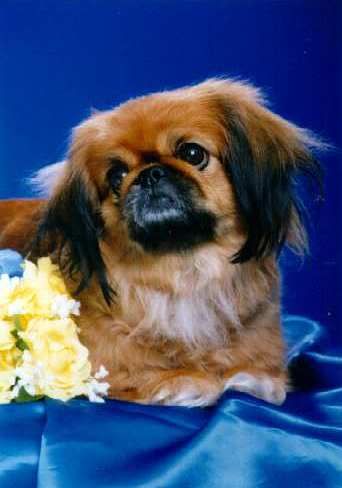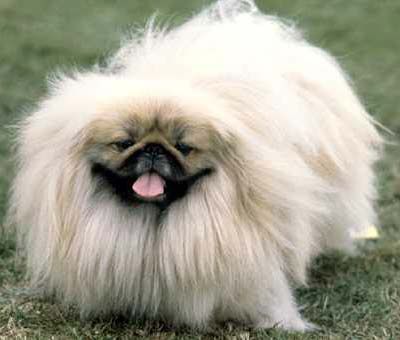Post by charmingnancy on Jan 6, 2009 18:38:28 GMT -5
Pekingese
Group: 5- Toys
Origin: Peking, China
Purpose: Companions of Chinese Royalty

Description:
Also commonly referred to as a "Lion Dog" or "Foo (or Fu) Dog" due to their resemblance to Chinese guardian lions, the Pekingese is an ancient breed of toy dog, originating in China. They were the favored pet of the Chinese Imperial court, and the name relates to the city of Beijing where the Forbidden City resides.
Appearance- Breed Standards:
Coat and Colour: Coat long, with thick undercoat, straight and flat, not curly nor wavy, rather coarse, but soft; feather on thighs, legs, tail and toes long and profuse. Mane profuse, extending beyond the shoulder blades, forming ruff or frill round the neck. All colours are allowable. Red, fawn, black, black and tan, sable, brindle, white and particolour well defined: black masks and spectacles around the eyes, with lines to ears are desirable. The colouring of a particoloured dog must be broken on the body. No large portion of any one colour should exist. White should be shown on the saddle. A dog of any solid colour with white feet and chest is not a particolour.
Head: Skull massive, broad, wide and flat between the ears (not dome shaped), wide between the eyes. Stop deep. Muzzle wrinkled, very short and broad, not overshot nor pointed. Strong, broad underjaw, teeth not to show. Nose black, broad, very short and flat. Eyes large, dark, prominant, round, lustrous. Ears heart shaped, not set too high, leather never long enough to come below the muzzle, nor carried erect, but rather drooping, long feather.
Forequarters: Firm at shoulder, bone of forearm bowed, short forelegs.
Body: Back level. Not too long in body; allowance made for longer body in bitch. Heavy in front, well-sprung ribs, broad chest, falling away lighter behind, lion-like.
Hindquarters: Hind legs lighter than forelegs but firm and well shaped. Feet flat, toes turned out, not round, should stand well up on feet, not on ankles.
Tail: Set high; lying well over back to either side; long, profuse, straight feather.
Faults: Protruding tongue, badly blemished eye, overshot, wry mouth.
Disqualifications: Weight over 14 lb. (6 kg); Dudley nose.
Gait: Fearless, free and strong, with slight roll.

Size:
Pekes weigh from 7 to 14 pounds (3-6 kg) and stand about 6-9 inches (15-23 cm) at the withers, however they can sometimes be smaller. These smaller Pekes are commonly referred to as "Sleeve" Pekingese or just "Sleeves". The name is taken from ancient times, when emperors would carry the smallest of the breed in their sleeves.
Temperament:
These dogs can be stubborn and jealous. They are childlike and can be opinionated at times. Do not expect this dog to come when it is called. Pekes are sometimes extremely aggressive, they have been known to bite other dogs and humans. It may take a long time for Pekes to get used to any other dogs except puppies, mates, and siblings. However, Pekes can be properly socialized with dogs and other types of pets and can become fast friends. The Pekingese personality has been compared to a cat, although this isn't quite right. It simply doesn't realize that it is a dog and would not like to be treated as such. Where a cat can be trained, a Pekingese needs to be convinced that the training is beneficial to the dog and the owner. The Pekingese is generally a one-person dog. They are loyal and tend to be very protective of their owner.
Health:
The leading cause of death for Pekes, as for many other Toy breeds, is congestive heart failure. When diagnosed early and successfully treated with medication, a Peke with this problem can expect to live many years. A heart murmur is a potential sign of a problem, and must be evaluated by a veterinary cardiologist. Very often, the problem does not surface until the dog is 6 or more years old, so it is very difficult to screen the problem in a pup.
Pekes' other main problems are eye issues and breathing problems, resulting from its tiny skull and flattened face, and skin allergies (and hotspots). An especially common problem is eye ulcers, which may develop spontaneously. Pekes should never be kept outside as their flattened faces and noses can develop breathing problems, which makes it difficult for them to regulate their body temperature in overly hot or cold weather. Due to their abundance of hair, it is important to keep the Pekingese cool. Pekes are indoor dogs and they are prone to having heatstroke when exposed to high temperature. Their long backs, relative to their legs, make them vulnerable to back injuries.
Average Lifespan:
13-15 years.

History:
The breed originated in China in antiquity, in the city of Peking most likely from Asian wolves. Another theory proposed by Professor Ludvic von Schulmuth is that the "Gobi Desert Kitchen Midden Dog", a scavenger, evolved into the "Small Soft-Coated Drop-Eared Hunting Dog". From this dog evolved the Pekingese, Tibetan Spaniel, and Japanese Chin. For centuries, they could be owned only by members of the Chinese Imperial Palace. The Pekingese were so treasured by the royalty that punishment for stealing one was death. In 1860, the breed finally made its way out of the palace, although even today it retains its need to be pampered. It was first shown in Britain in 1893 and was recognized by the AKC in 1909. Today the Pekingese is loved and pampered as both a show dog and companion pet.
Sources:
Wikipedia
5 Star Dog
CKC
Pictures:
Photobucket
Group: 5- Toys
Origin: Peking, China
Purpose: Companions of Chinese Royalty

Description:
Also commonly referred to as a "Lion Dog" or "Foo (or Fu) Dog" due to their resemblance to Chinese guardian lions, the Pekingese is an ancient breed of toy dog, originating in China. They were the favored pet of the Chinese Imperial court, and the name relates to the city of Beijing where the Forbidden City resides.
Appearance- Breed Standards:
Coat and Colour: Coat long, with thick undercoat, straight and flat, not curly nor wavy, rather coarse, but soft; feather on thighs, legs, tail and toes long and profuse. Mane profuse, extending beyond the shoulder blades, forming ruff or frill round the neck. All colours are allowable. Red, fawn, black, black and tan, sable, brindle, white and particolour well defined: black masks and spectacles around the eyes, with lines to ears are desirable. The colouring of a particoloured dog must be broken on the body. No large portion of any one colour should exist. White should be shown on the saddle. A dog of any solid colour with white feet and chest is not a particolour.
Head: Skull massive, broad, wide and flat between the ears (not dome shaped), wide between the eyes. Stop deep. Muzzle wrinkled, very short and broad, not overshot nor pointed. Strong, broad underjaw, teeth not to show. Nose black, broad, very short and flat. Eyes large, dark, prominant, round, lustrous. Ears heart shaped, not set too high, leather never long enough to come below the muzzle, nor carried erect, but rather drooping, long feather.
Forequarters: Firm at shoulder, bone of forearm bowed, short forelegs.
Body: Back level. Not too long in body; allowance made for longer body in bitch. Heavy in front, well-sprung ribs, broad chest, falling away lighter behind, lion-like.
Hindquarters: Hind legs lighter than forelegs but firm and well shaped. Feet flat, toes turned out, not round, should stand well up on feet, not on ankles.
Tail: Set high; lying well over back to either side; long, profuse, straight feather.
Faults: Protruding tongue, badly blemished eye, overshot, wry mouth.
Disqualifications: Weight over 14 lb. (6 kg); Dudley nose.
Gait: Fearless, free and strong, with slight roll.

Size:
Pekes weigh from 7 to 14 pounds (3-6 kg) and stand about 6-9 inches (15-23 cm) at the withers, however they can sometimes be smaller. These smaller Pekes are commonly referred to as "Sleeve" Pekingese or just "Sleeves". The name is taken from ancient times, when emperors would carry the smallest of the breed in their sleeves.
Temperament:
These dogs can be stubborn and jealous. They are childlike and can be opinionated at times. Do not expect this dog to come when it is called. Pekes are sometimes extremely aggressive, they have been known to bite other dogs and humans. It may take a long time for Pekes to get used to any other dogs except puppies, mates, and siblings. However, Pekes can be properly socialized with dogs and other types of pets and can become fast friends. The Pekingese personality has been compared to a cat, although this isn't quite right. It simply doesn't realize that it is a dog and would not like to be treated as such. Where a cat can be trained, a Pekingese needs to be convinced that the training is beneficial to the dog and the owner. The Pekingese is generally a one-person dog. They are loyal and tend to be very protective of their owner.
Health:
The leading cause of death for Pekes, as for many other Toy breeds, is congestive heart failure. When diagnosed early and successfully treated with medication, a Peke with this problem can expect to live many years. A heart murmur is a potential sign of a problem, and must be evaluated by a veterinary cardiologist. Very often, the problem does not surface until the dog is 6 or more years old, so it is very difficult to screen the problem in a pup.
Pekes' other main problems are eye issues and breathing problems, resulting from its tiny skull and flattened face, and skin allergies (and hotspots). An especially common problem is eye ulcers, which may develop spontaneously. Pekes should never be kept outside as their flattened faces and noses can develop breathing problems, which makes it difficult for them to regulate their body temperature in overly hot or cold weather. Due to their abundance of hair, it is important to keep the Pekingese cool. Pekes are indoor dogs and they are prone to having heatstroke when exposed to high temperature. Their long backs, relative to their legs, make them vulnerable to back injuries.
Average Lifespan:
13-15 years.

History:
The breed originated in China in antiquity, in the city of Peking most likely from Asian wolves. Another theory proposed by Professor Ludvic von Schulmuth is that the "Gobi Desert Kitchen Midden Dog", a scavenger, evolved into the "Small Soft-Coated Drop-Eared Hunting Dog". From this dog evolved the Pekingese, Tibetan Spaniel, and Japanese Chin. For centuries, they could be owned only by members of the Chinese Imperial Palace. The Pekingese were so treasured by the royalty that punishment for stealing one was death. In 1860, the breed finally made its way out of the palace, although even today it retains its need to be pampered. It was first shown in Britain in 1893 and was recognized by the AKC in 1909. Today the Pekingese is loved and pampered as both a show dog and companion pet.
Sources:
Wikipedia
5 Star Dog
CKC
Pictures:
Photobucket

